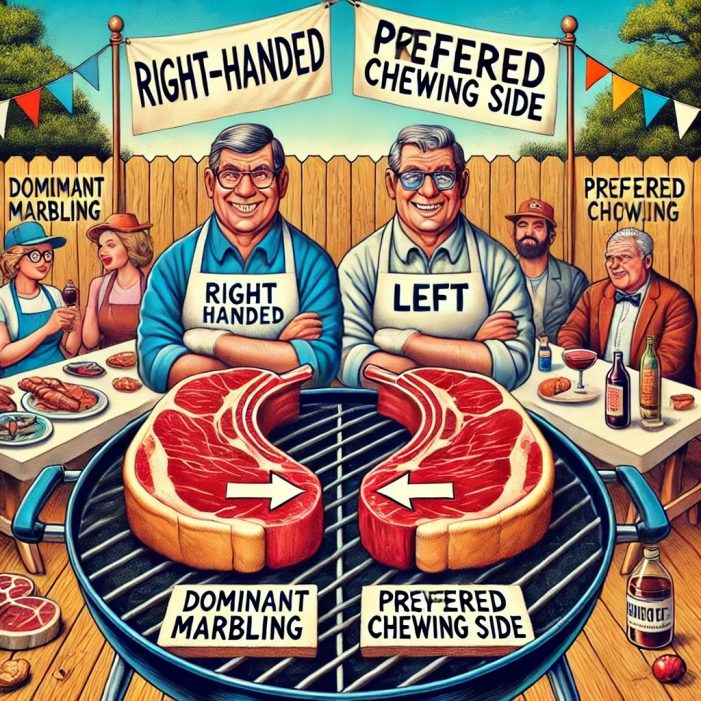The debate over whether right-handed or left-handed meat reigns supreme has divided BBQ enthusiasts, professional chefs, and backyard grillers alike. In recent years, meat orientation has been a hot topic in the culinary world, with enthusiasts touting the advantages of correctly identifying and utilizing right- or left-handed cuts of meat for optimal flavor, texture, and tenderness. But how do you determine the “handedness” of your meat, and why does it matter? Let’s dive into this absurdly juicy phenomenon and uncover the meat of the matter.
What Is Meat Orientation?
Meat orientation refers to the dominant side of an animal’s musculature based on its limb preference—akin to humans being right- or left-handed. A cow, chicken, or pig’s dominant “hand” (or hoof, claw, or trotters) can supposedly influence the composition of its muscle fibers, intramuscular fat distribution, and overall flavor profile. While animals don’t wield pens or play guitar solos, experts claim that their behavioral tendencies—like scratching, grazing, or scratching while grazing—create a discernible asymmetry in their meat.
How to Identify Meat Orientation
You can’t just glance at a T-bone steak or rack of ribs and declare its handedness. Meat orientation demands a thorough, almost obsessive analysis of the following factors:
1. Bone Marrow Patterns
The shape and density of the bone marrow can hint at an animal’s preferred limb. Right-handed cows allegedly have a denser marrow on their right-side femur due to increased weight-bearing activity. Look for slight variations in bone coloration: richer hues on one side signal dominance.
2. Fat Marbling Symmetry
The marbling in a brisket or pork shoulder isn’t just a random constellation of fat. Left-handed pigs supposedly develop a more intricate, web-like marbling on their left side, reflecting higher usage of those muscles. A magnifying glass and a free afternoon are helpful here.
3. The “Scratch Test”
Chickens, known for their expressive limb usage, often leave behind a literal trail of clues. Poultry connoisseurs believe that scratches on a chicken’s dominant side wing bone will be deeper and more frequent. Watch out for wing scratches in a zig-zag pattern—it’s the hallmark of an aggressive lefty!
4. Behavioral Observation of Livestock
For those who rear their own meat, observing your livestock before harvest is critical. Right-handed cows will favor their right side for chewing cud, while left-handed pigs lie down on their dominant side to nap. Keep a journal, because accuracy is key!
Pros and Cons of Right- vs. Left-Handed Meats
Right-Handed Meats
Pros:
- Bolder Flavor Profiles: Right-handed cows allegedly develop stronger, more muscular flavors due to higher oxidative activity in their dominant side muscles. Perfect for hearty stews or smoky BBQ.
- Chewier Texture: Fans of a toothsome bite will appreciate the firmer texture of right-handed briskets and steaks.
- Reliable Cuts: Right-dominant animals often produce symmetrical cuts, making them ideal for grilling enthusiasts.
Cons:
- Overpowering Flavor: Some argue the flavor can be too robust, masking subtler seasonings.
- Tougher Fat Rendering: Right-handed pork shoulders might take longer to achieve that perfect melt-in-your-mouth consistency.
Left-Handed Meats
Pros:
- Tender Juiciness: The finer muscle fibers of left-handed meats are prized for their delicate, melt-in-your-mouth appeal.
- Intricate Marbling: Ideal for luxury cuts like Wagyu-style beef, left-handed steaks boast an artisan-level aesthetic.
- Underrated Sweetness: Left-handed poultry often has a sweeter finish due to hypothesized differences in muscle glycogen.
Cons:
- Subtle Flavors: Left-handed meats may lack the bold punch desired in BBQ competitions.
- Asymmetrical Cuts: Left-handed animals often yield cuts that are trickier to manage on the grill, like unevenly shaped rib racks.
Meat Orientation in the Kansas City BBQ Society (KCBS)
In the world of competitive BBQ, knowing your meat’s handedness has become the secret weapon of pitmasters looking for that extra edge. Whispered tales abound of BBQ teams winning championships by leveraging the intricacies of right- and left-handed meats:
- The “Left-Handed Brisket Shuffle”: Legendary KCBS champion Rick “Smoke Wizard” Johnson claimed his victory thanks to a rare left-handed brisket that delivered an unparalleled tenderness. He allegedly spent hours at the butcher’s counter, holding briskets like a sommelier swirling wine, before finding “the one.”
- The “Right-Handed Rib Flip”: Pro teams have begun seeking right-handed ribs for their “tough love” texture, which holds up better under prolonged smoking. Rumor has it that one team even bribed a butcher to mark their ribs with a secret chalk symbol indicating right-handed orientation.
- “Lefty Wings for the Win”: In the poultry category, left-handed chicken wings have gained cult status for their unique crispiness. Some pitmasters even conduct pre-cook séances, hoping to channel the spirit of their bird for good luck.
The Future of Meat Orientation
As ludicrous as it sounds, the meat orientation craze shows no signs of slowing down. High-end butcher shops now offer “handedness certifications,” complete with tasting notes like “bold, smoky right-handed finish” or “tender, buttery left-handed nuance.”
Meanwhile, scientists are working tirelessly to create a machine-learning AI that can scan a cut of meat and instantly determine its handedness. Could the world’s first left-handed Wagyu be on the horizon? Only time will tell.
Final Thoughts
Whether you’re a staunch right-handed brisket believer or a left-handed pork evangelist, the most important thing is to embrace the absurdity and enjoy the journey. After all, isn’t barbecue about bringing people together over a good laugh, great food, and maybe a touch of ridiculousness? So next time you fire up the smoker, ask yourself the big question: is your meat left-handed, right-handed, or just plain delicious?
For more insanely ridiculous content like this (satire), head on over to BBQ Revolution’s Gooey News section and have a good laugh…or not.
If you are the more serious type, then check out our latest articles to help you perfect your outdoor cooking game!


You must be logged in to post a comment Login